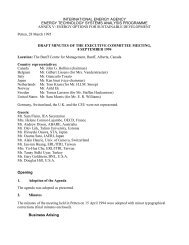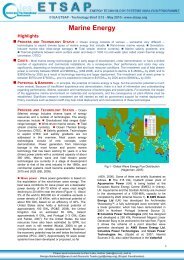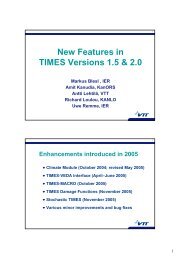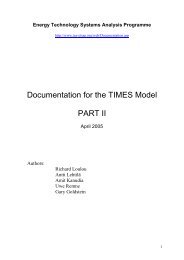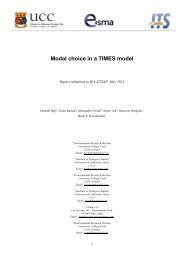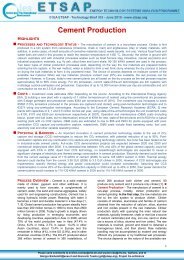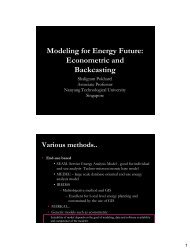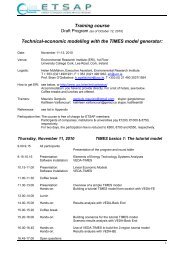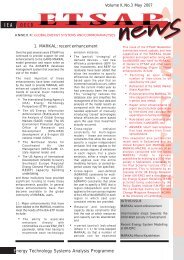Documentation for the MARKAL Family of Models - iea-etsap
Documentation for the MARKAL Family of Models - iea-etsap
Documentation for the MARKAL Family of Models - iea-etsap
Create successful ePaper yourself
Turn your PDF publications into a flip-book with our unique Google optimized e-Paper software.
9. Repeat steps 7 and 8 call DDFCalib with Run# not = 1, until satisfied.<br />
10. Compare demands from <strong>the</strong> and <strong>for</strong> each demand category.<br />
These can be found in table DEMAND <strong>of</strong> <strong>the</strong> .ANT files. If <strong>the</strong>re are some<br />
categories whose demands differ too much, it might be that <strong>the</strong> value <strong>of</strong> DMTOL in<br />
table CONSTANT is too big. In this case, lower <strong>the</strong> value <strong>of</strong> DMTOL, and repeat<br />
steps 7, 8 and 10.<br />
The reason <strong>for</strong> lowering DMTOL is simply to prevent MM calculated demand (D)<br />
from hitting <strong>the</strong> lower bound set in MMACRO.MM, i.e.:<br />
D.LO(DM,TT) = DMTOL * D0(DM).<br />
If <strong>for</strong> some demand categories (in any time period), D needs to be smaller than D.LO<br />
to match <strong>the</strong> projected demands, <strong>the</strong>n MM calculated demands will be higher than <strong>the</strong><br />
projected demands. This is <strong>the</strong> only possible cause <strong>for</strong> MM calculated demands to<br />
differ much from <strong>the</strong> projected demands.<br />
11. Move <strong>the</strong> in<strong>for</strong>mation from <strong>the</strong> DDF.DD file into your database.<br />
Comments<br />
1. The matching <strong>of</strong> MM calculated GDP growth rates with projected GDP growth rates<br />
is separable from <strong>the</strong> matching <strong>of</strong> demands.<br />
Since <strong>the</strong> usual projection <strong>for</strong> <strong>the</strong> economic indicators are <strong>for</strong> GDP growth rates, not<br />
<strong>the</strong> potential GDP growth rates (GROWV), DDFNEW incorporates <strong>the</strong> matching <strong>of</strong><br />
projected GDP growth rates with <strong>the</strong> matching <strong>of</strong> projected demands in <strong>the</strong> utility.<br />
However, it is possible to match only <strong>the</strong> projected demand, but not <strong>the</strong> projected<br />
GDP growth rates. In this way, <strong>the</strong> # <strong>of</strong> iteration to get <strong>the</strong> demand matching will be<br />
less than <strong>the</strong> standard version <strong>of</strong> DDFNEW.<br />
Matching only <strong>the</strong> demands can be done by not updating GROWV, but to keeping it<br />
constant in <strong>the</strong> DDFNEW.DD file. This can be done, <strong>for</strong> example, by simply setting<br />
GROWVN(TP) = GROWV(TP);<br />
instead <strong>of</strong><br />
GROWVN(TP)$(TLAST(TP)) = GR(TP);<br />
GROWVN(TP)$(NOT TLAST(TP)) = GROWV(TP) + GR(TP) - GG('GDP',TP);<br />
in <strong>the</strong> RWDDF.MM file, in your GAMS_SrcXXX folder. [Note, you should move<br />
RWDDF.MM to you GAMS_WrkXXX folder be<strong>for</strong>e editing it.]<br />
415




